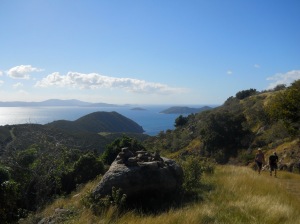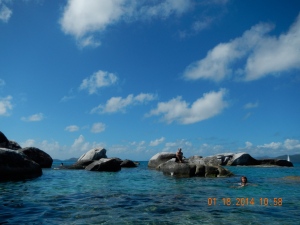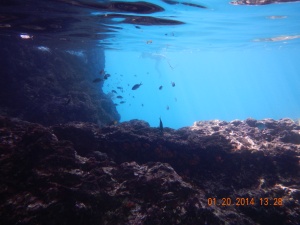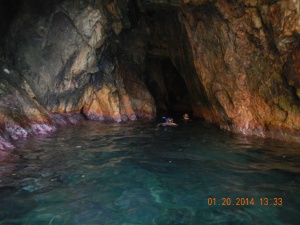Shortly after Molly’s parents left, we set off for the British Virgin Islands, which are are right next to the USVIs. Other than being British, the biggest difference is that they are generally smaller and less populated. However, there are a lot of them.
Our first stop was Jost Van Dyke, home of the legendary Foxy’s Bar and Restaurant, which is practically the only thing of note on the entire island. On our first trip twelve years ago, I had particularly enjoyed meeting Foxy himself and listening to his singing and jokes. Unfortunately, we weren’t as fortunate this time, and didn’t get to see him perform.
Shortly after we arrived on the tiny beach-lined harbor of Jost Van Dyke (pronounced yost), Scott, Molly, Isaac, and I set off up the steep, almost ladder-like hill overlooking the harbor. Twelve years ago, we did this same hike, and I had remembered it as being hot, sweaty, difficult, yet rewarding. And it was pretty much the same this time around, only perhaps a little more difficult. The dirt road often gave way under foot, which often added up to two steps forward, one step back. But the view of the harbor and neighboring islands was quite spectacular. During the hike, we were constantly running into groups of goats grazing on the grassy hillside.
After we left Jost we hopped over to Great Camano Island for the night. In our anchorage it seemed as if we’d left the Caribbean and were transported back to Maine, with it steep rocky shores and gravely beach, and peaceful evening silence with just a handful of houses visible up on the hill. The biggest difference was the wildlife. Flocks of pelicans flew in formation, hovering over the water. Every so often, one would plummet into the water after a fish, splashing water far into the air.
The next morning, as we pulled up the anchor, I heard an eerie scream of someone in distress. I looked around, saw no one in imminent danger, and realized it was the goats on shore, with their near-human-like screams. On our way out of Great Camano Island we had to go through the narrow Camano passage. We lacked detailed charts for this area, so Scott was sent aloft to look for water color changes indicative of sudden depth changes, while Isaac, Molly, and I were on the bow doing the same.
There were several shoals in the vicinity, but we made it through intact. That evening, we anchored in Spanish Harbor, the main town on Virgin Gorda, and treated ourselves to wifi and nachos ashore. It had been a while since we’d had internet access, and we all pulled out laptops, iPads, smartphones, etc. and munched silently and checked emails and whatnot, completely ignoring the scenery. Another bar patron, clearly on vacation and not suffering from internet withdrawal thought we were a comical sight and took our picture.
The next morning it was off to the Baths! Thousands of years of wind and waves had sculpted unique rock formations out of a tumble of enormous boulders from past volcanic activity to form unique landscapes and breathtaking seaside caverns and passages. Climbing and swimming around the boulders was like crawling through an excellent natural jungle gym. Inside the dimly lit sea caves, tiny white fish would play about our waists and jump if we moved too quickly.
We crawled in amongst the gian boulders. They were everywhere. Along the sandy path, on the shorline, partially submerged, creating labyrinthine pools in the water. We swam in amongst the giants and scrambled up among them chasing scuttling crabs.
You are not allowed to anchor at the Baths overnight, so after we were done exploring, we set off for Peter Island. We anchored in a pleasant bay, surrounded by nothing but a few other sailboats. But, it wasn’t quite as peaceful as you’d expect, since the everpresent goats were soon bleating ashore. Shortly after we’d dropped anchor, a floating grocery store came along side us. We had provisioned recently, so we didn’t need anything, but we couldn’t say no to ice cream bars, a rare treat for us due to our inability to keep frozen treats onboard.
As if the day hadn’t been perfect enough, that evening we were treated to some fantastic bioluminescence. We could see comet-like streaks of light left by fish darting through the water and we splashed about with an oar, filling the ocean with starts.

The tumbled down houses of Salt Island, on a thin strip of sand between sea (left) and salt pond (right)
Next up was Salt Island. As the name implies, the island was once used to manufacture salt with the two salt ponds on the island. The island seems to no longer be used for this purpose, as it reeks of dead fish in the high salinity ponds. The island is now all but deserted. The few small, ramshackle houses on shore were slowly breaking down, with doors missing and rooms empty of all but scattered debris. The highlight of Salt Island was the snorkeling. We were surrounded by creepy schools of squid or cuttlefish (we aren’t sure which), and Scott and Molly found an octopus atop his garbage heap of empty conch shells. But since there was little else to see on Salt Island, we quickly moved on.
Norman Island is almost synonymous with pirates and buried treasure. Many locals call it Treasure Island as supposedly real pirate treasure was buried there at one point. On our first trip, we had set out in our dinghy to snorkel the famous sea caves on Norman Island, but rough weather and outboard motor troubles prevented us. But the 12 year wait was worth it. It was easily the best snorkeling of the trip thus far. We saw blue tang, small-mouthed grunt, sergeant major, rainbow parrotfish, squirrel fish, and fairy basset. (I looked them up on our fish ID card as soon as we got back) The aptly named rainbow parrot fish was my favorite, with its bright plumage and beak-like mouth.
The sea caves themselves were a unique experience. We’d read that it gets quite dark, so we’d come prepared with a waterproof flashlight, but even with that it was extremely creepy. The narrow cave was quite deep–deeper than we cared to venture. It is the sort of place you might see at the start of a horror film, where vacationers are slowly picked off by a human-fish hybrid monster. Something very primal pricks up in dark, enclosed, natural spaces and tells you to get the heck out of there. So we did.
After our whirlwind tour of the British Virgins, it was back to the USVIs for reprovisioning before continuing our voyage south.







I continue to enjoy reading your posts. Thanks for letting me (and others, of course) enjoy your trip from afar. Jack
Reminded of our time in BVI and our visit to the Baths. Did you try the passage between Gorda and Jerusalem Island? Nice little rock in the middle to give you a challenge!
Hi Isaac! Danica, and family!
Great write up on BVI…..it really is fun to virtually “join” you on these adventures. I could not swim an inch into one of those sea caves! I just checked route map…looks like,you are in Grenada! Congratulations.
Sail on and keep writing!
Lisa Martin